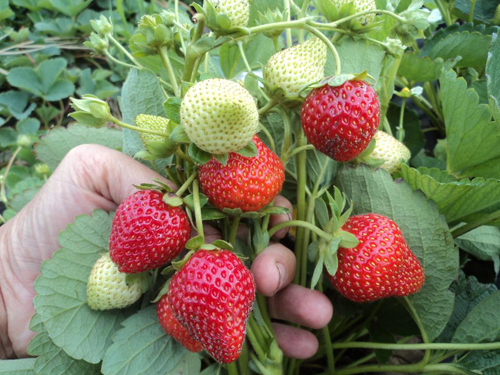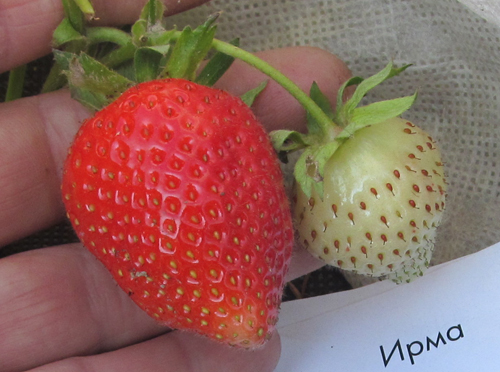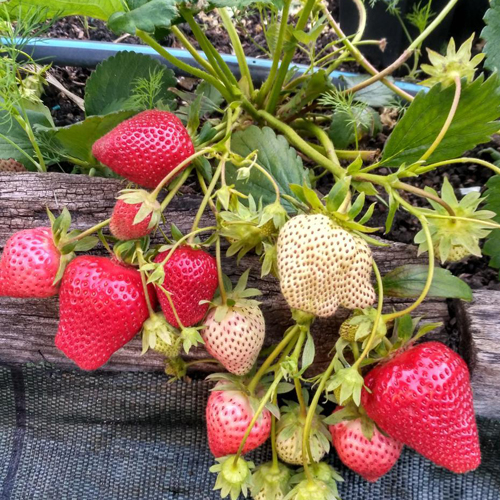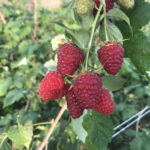Irma strawberry variety
Irma is a variety of garden strawberries of neutral daylight hours (NSD), or, as we call them, remontant. Bred in the city of Verona, Italy. The pedigree includes varieties such as Marmolada, Addie, Earliglow. "Parents" are Don

In terms of ripening, this is an early remontant, it begins fruiting one of the first in its class and is almost on a par (perhaps a discrepancy within five days) with early strawberry varieties of short daylight hours (Alba, Clery
The plant is medium-sized, stocky, with large, not too dense leaves of a dark green color. The roots are powerful, thanks to this, the variety is drought-resistant. Peduncles are long and well developed, set high. Flowers have good self-pollination, which is especially important when growing plants indoors or under cover. Usov gives an average number, large rosettes, especially of the first and second order.

The strawberry berry is beautiful, elongated, conical in shape, with a pronounced neck, bright red in color. Very tasty, sweet, juicy, with a good balance of sugar and acid, aromatic. Large and very large in size, the average weight in the season is 25-30 grams, but often the weight of the fruits reaches 60 grams, especially in the first wave of fruiting in spring. Then it is really easy to find such "berries" on the garden bed with Irma that one just cannot believe in their existence right away. A couple of such specimens can hardly fit on a woman's palm, but what about a woman's - and not on every man's!
Although the pulp is of medium density, the skin is very strong, which provides good transportability and keeping quality. Interestingly, Irma has the best taste and aroma during autumn fruiting, and the berry also becomes denser. In the spring, early fruits do not have time to completely pick up sugar due to lack of sun, in summer, on the contrary, from an excess of sunlight and sultry weather, the berry loses both in size and taste.

Strawberries are frost-resistant, but for the winter it is desirable to shelter with agrofibre (lutrasil), it is tolerant to the main types of diseases of garden strawberries, including fungal infections.
The variety is very productive. The average yield, subject to all the necessary agrotechnical techniques, is 1 kg per bush, but it can also exceed this figure, especially when grown in greenhouses.
When cultivating varieties of neutral daylight hours (remontants), it is advisable to keep them in the garden for one year (provided that they are planted early with good quality seedlings so that the plant can fully spend the entire season). Maximum two years, but no more. Then you should update the planting of strawberries. Irma is no exception. And that's why.
- Although the berry remains large, the size is still smaller than that of the first years, and the quality becomes worse. As a result, the yield drops compared to the first year of cultivation.
- The row thickens strongly, the peduncles become shorter, and the berry cannot always be seen, more energy is spent on searching and sampling, and the fruit that has not been harvested in time quickly overripens and can rot, spreading the infection.
- The accumulation of pathogens in the soil increases, which increases the risk of disease occurrence, which is also facilitated by the thickening of the plantings.
- The formation of seedlings is significantly reduced, and to start a new plantation, renew an old one or grow seedlings for sale, you need to take seedlings from plants of the first year of planting.
- Bushes rise above the ground, partially exposing the root system, and in winter strawberries can freeze without shelter, and in summer, on the contrary, dry out.
The main advantages of Irma are the excellent taste of berries, high yield, early ripening, excellent keeping quality and transportability. Of the minuses, only the peculiarity of the variety as remontant can be noted - a strong decrease in the yield of the plant after two years of cultivation. Gardeners also noticed a deterioration in fruiting in very hot seasons, although this strawberry is drought tolerant. However, the problem is solved by timely watering and shading.
Author: Maxim Zarechny.








